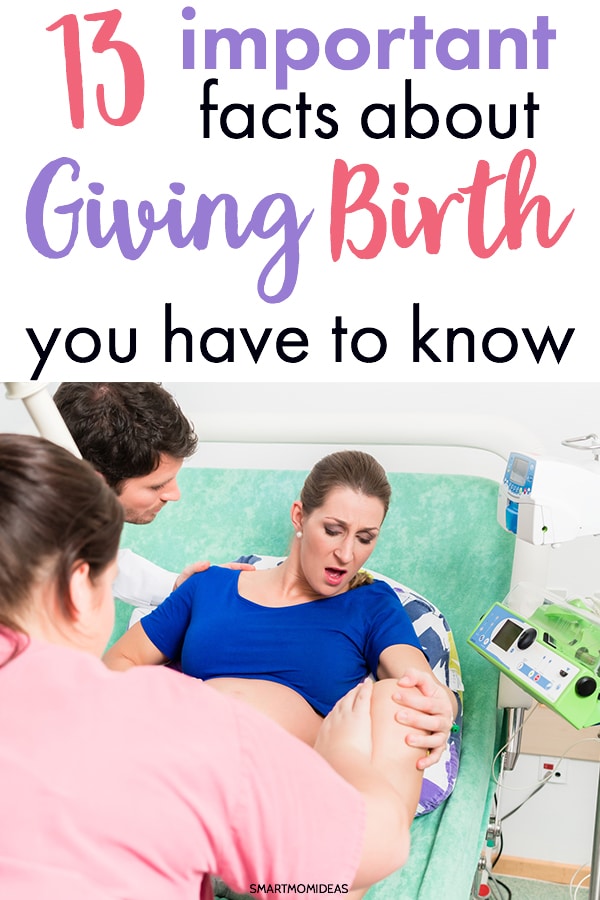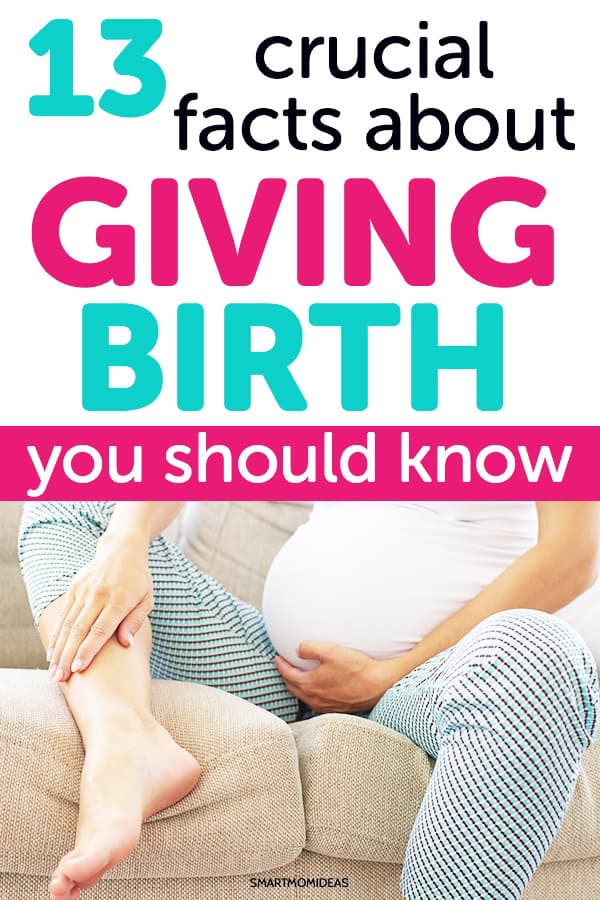Learn what really happens when you give birth for the first time.

Even though millions of women around the world have done it, giving birth for the first time is a terrifying mystery for new mothers.
The mechanics are pretty straightforward – labor, contractions, push, baby – but there are so many other things to consider when facing the experience of childbirth.
I had a slightly complicated pregnancy with twins and that resulted in a c-section delivery.
But, my friends and family have had natural births and while I was pregnant that is all I studied!
Thankfully, this list will shed some light on various aspects of childbirth and give you a more informed idea of what to expect during one of the most amazing and memorable experiences of your life.
The Best Online Birthing Class for New Moms

There are many resources for pregnant moms that want a natural childbirth. But, one of the best types are ones you can do at your own pace and in the comfort of your home.
The KOPA Birth Class for Natural Birth shows you exactly what to expect when giving birth for the first time. There are video lessons to show you the process of getting ready for birth.
If you feel you need that extra help and support to ease any fears you may have about birth, the KOPA Birth Class is a great resource.
1. There are 3 Stages of Labor
The first stage is divided into “early labor” and “active labor.”
Early labor happens when the cervix thins out (effaces) and opens (dilates) in preparation for birth. Active labor happens next when the dilation occurs more rapidly and contractions are stronger and longer.
Stage three is the “pushing” stage.
As you can guess, this is when you are fully dilated and ready to push your baby out. The last stage happens after your baby is born and you need to push out the placenta.
2. The Experience of Labor Varies from Mother to Mother
There’s no standard experience for all mothers giving birth. Some experience short and painful labors, others long and easy ones.
There is a widely accepted standard that states women who have not previously delivered a child through vaginal birth may experience 10-20 hours of labor compared to those who have delivered vaginally in the past.
They’ll likely experience shorter labor.
3. Labor Contractions Feel Like Severe Menstrual Cramps
Again, all women experience the pain of birth differently, but for the most part labor feels like really bad period cramps. They typically cause discomfort or a dull ache in the back and lower abdomen.
The intensity of the discomfort or pain may even result in nausea and vomiting for some women.
4. Before Labor Begins, You May Experience “Bloody Show” and/or Your Water Breaking
Bloody show is a mucusy vaginal discharge with a tinge of blood.
This is sometimes referred to as “losing your plug,” since the discharge is caused by the detachment of the cervical mucus plug (the bit that seals your cervix during your pregnancy).
This is usually a pretty good sign that you are going to begin labor soon.
Another telltale sign of labor gearing up is when the amniotic sac that surrounds your baby ruptures – which is usually referred to as your water breaking.
These both occur during the “early labor” stage so, depending on how dilated your cervix is, you may not be ready to hunker down at the hospital at this point
5. The Transition from Active Labor to Pushing May Feel Like You Have to Poop
Once your baby starts to travel down the birth canal, his or her head is going to start placing pressure against the vaginal opening and perineum (the skin between your vagina and anus).
You’re probably going to feel like you have to poop.
However, if you have an epidural, you may not feel this at all.
The numbness and lose of sensation caused by the epidural makes it harder to push – you may not feel anything until the baby’s head has descended into the cervix.
6. There’s a Cut-Off Time for Getting an Epidural
Once your baby’s head starts to crown (when the baby’s head starts to emerge through the vaginal opening), it is too late to request an epidural.
Likewise, the anesthesiologist may advice against the epidural if you are unable to stay still long enough to have it administered.
Alternatively, you are not likely to get an epidural until you’re about 4-5 centimeters dilated.
7. Your Caregiver Will Guide You Through the Pushing Process
Whether you have an OB-GYN, nurse practitioner or doula helping you through your labor, you’ll have someone there to guide you through the pushing.
They may have you push hard and long or in short bursts, depending on the baby’s position and location.
You will also be guided through pushing the placenta out.
8. You Will Feel Contractions After Birth
After your baby’s birth, you uterus will begin to contract and firm up.
This is necessary in order to close up the blood vessels where the placenta was attached.
If you place your hand on your stomach, you’ll be able to feel your stomach harden during this process. Should your uterus not naturally contract, your caregiver may massage the area to encourage contractions.
9. You May Require an Episiotomy or Experience Tearing
An episiotomy is a surgical cut made my the doctor at your vaginal opening.
Once routine in all births, episiotomies are only performed if necessary, usually if your baby’s shoulders are stuck, their heart-rate is abnormal or if forceps or vacuum are required.
Even if an episiotomy is not required, you may experiencing tearing in the area. Most women, especially those who elect for the epidural, do not even feel the tearing when it happens.
Whether surgically cut or torn, stitches are used to reconnect the tissue. Your doctor may prescribe medication to ease the pain of recovery and/or recommend stool softeners to avoid the strain of having a bowel movement.
10. Immediately Breastfeeding Your Baby After Birth is Important
Even before your little one is cleaned up and weighed, you should take the opportunity to experience skin-on-skin contact and allow your baby to seek your breast.
Your baby is alert following birth and will “root” for the breast with his or her mouth.
Allowing him or her to feed during this time is beneficial to both mother and child: immediate breastfeeding helps to build confidence in breastfeeding for mom and provides the baby with colostrum.
Colostrum is the “first milk” that comes from the breast and provides the baby with protection against infection and disease.
11. Your Baby Will Need Eye Drops and a Vitamin K Shot Following Birth
After those first precious moments of bonding, your child will be weighed and given eye drops and a shot of vitamin K.
The antibiotic eye drops are given to protect the baby from bacterial eye infections that can be picked up during birth.
Cloudiness, redness and swelling may occur due to the drops, but these side-effects are short term.
The vitamin K shot is important to help with blood clotting. Without it, babies are at risk of developing vitamin K deficiency bleeding which causes internal bleeding and may result in death.
12. If You Can’t Deliver Vaginally, You Will Require a C-Section
Cesarean delivery, or C-section, involves a surgical incision in the abdomen and uterus in order to delivery the baby. If there are pregnancy complications, or if you have had a C-section in the past, a cesarean delivery may be planned ahead.
Otherwise, an emergency C-section may be required if your health or the health of your baby’s health is at risk.
This may include distress of the mother or baby (high blood pressure and heart rate), prolapsed umbilical cord (the umbilical is coming out before the baby), a placenta abruption (the placenta peels away from the uterine wall) or hemorrhaging (excessive bleeding).
For me, I had a C-section for my twin pregnancy due to a preexisting condition and developing intrauterine growth restriction.
Because a C-section is a major surgery, your body will need lots of time to heal afterward. You will likely stay in the hospital for 3-4 days after delivery and have lifting and movement restrictions for 6 weeks.
13. You’ll Forget the Pain of Childbirth
This is probably the last thing you’ll believe during the thick of pushing out a baby, but it’s true – you will forget the pain.
Maybe it’s the overwhelming joy of loving your precious infant that eliminates the painful memories. Perhaps it’s the fact that your life is about to get a thousand times busier and crazier and you won’t have time to remember the pain.
Either way, childbirth is not the scary and torturous ordeal you may perceive it to be.
It hurts and it’s hard, but the end result is worth all of the pain and discomfort.
So much so, that some women choose to do it all over again.
Over to you – what did I miss? Share your labor tip in the comments!
Remember to pin me!





Leave a Reply